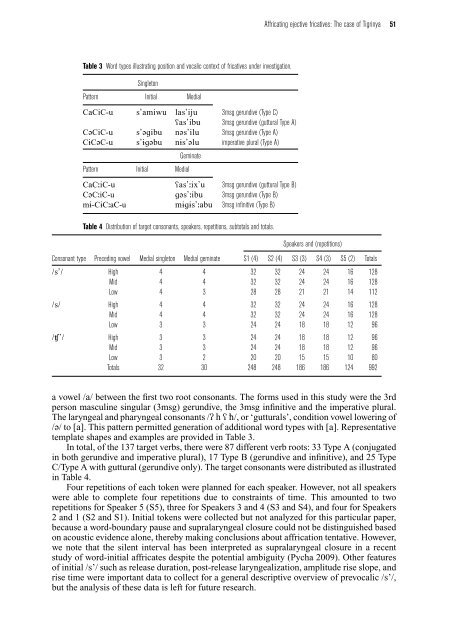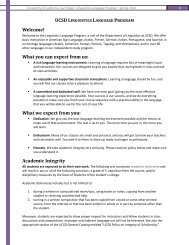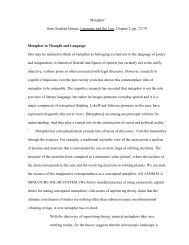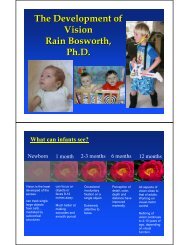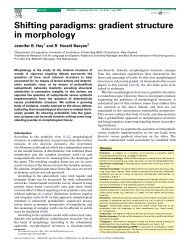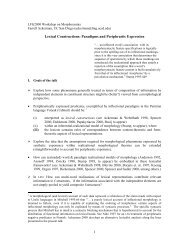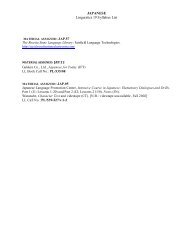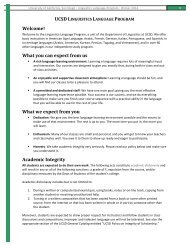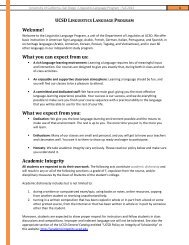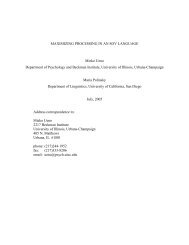50 Ryan K. Shosted & Sharon Roseaffrication hypothesis predicts that, apart from properties associated with alveolar versuspalato-alveolar place <strong>of</strong> articulation differences, /s’/ should share characteristics with /’/:similar release duration, high amplitude rise slope, and long rise time. Finally, we will discussthe likelihood that affrication is a viable strategy for satisfying the competing aeroacousticdemands involved in the production <strong>of</strong> simultaneous frication and ejectivity, particularly inlanguages that lack a corresponding <strong>ejective</strong> affricate.2 Method2.1 SpeakersData from five male subjects between the ages <strong>of</strong> 25 and 45 years were recorded. All subjectswere from Asmara, the capital city <strong>of</strong> Eritrea, and were native speakers <strong>of</strong> <strong>Tigrinya</strong>, having leftEritrea after reaching adulthood. All subjects also spoke English and Amharic. In addition,one subject spoke some Blin, a Cushitic language <strong>of</strong> Eritrea, and another was fluent in Italian.Uncompressed 16-bit wav-files <strong>of</strong> the subjects’ utterances were recorded on a Marantz PMD-660 solid state recorder. Recordings took place whenever possible in a sound-attenuatedbooth but alternatively in a quiet room in a private house. Subjects were recorded using aN/D267a Dynamic Cardioid table-top microphone, positioned approximately 10–12 inchesfrom their mouths. <strong>The</strong>y were instructed to remain as still as possible while speaking. Speechwas sampled at 48 kHz for the first four speakers and (inadvertently) at 44.1 kHz for the fifth.Because spectral measures were not included in the analysis the discrepancy in sampling rate,though unfortunate, was not considered problematic.2.2 TokensProduction consisted <strong>of</strong> a word list <strong>of</strong> 183 <strong>Tigrinya</strong> verb forms drawn from Kane (2000) (137target items and 46 fillers, including items with test consonants /t’/ and /S/, which do not formpart <strong>of</strong> our analysis here) in a carrier sentence: /t´mali ___ /ilu/ ‘Yesterday ___ he said’.<strong>The</strong>se were presented to the subjects in Ethiopic writing using Abyssinica font (www.sil.org):e.g./t´mali f´t’iru /ilu/ ‘Yesterday, he created, he said’. Gemination isnot normally indicated in Ethiopic writing, but can be marked with two dots over a symbol(Leslau 1995). Gemination diacritics were added as appropriate to ensure minimal pairs weredistinguished (e.g. /n´s’ilu/ ‘it came <strong>of</strong>f the handle’ vs. /n´s’˘ilu/ ‘he separated’).Subjects were given the chance to familiarize themselves with the extra diacritic beforebeginning the experiment, and subsequently had no trouble with its use. Sentences wererandomized and presented to subjects using Micros<strong>of</strong>t PowerPoint, with four sentences perslide. <strong>The</strong> investigator controlled slide transitions.<strong>The</strong> word list was designed to compare several factors. Five target consonants differingin manner <strong>of</strong> articulation and airstream mechanism were selected: /s ts’ t’ ’/. (We presentstatistical results bearing on /s s’ ’/ only.) Note that <strong>Tigrinya</strong> lacks the pulmonic singletonaffricate // except in loanwords, chiefly from Italian. Target consonants appeared in wordinitial position and in intervocalic medial position. Target consonants in medial positionwere either singleton or geminate. <strong>The</strong> vowel adjacent to the target consonant (in theantepenultimate syllable) was either low /a/, mid /´/ (slightly fronted) or high /ˆ/. This vowelfollowed the target consonant in initial position or preceded it in medial position. In <strong>Tigrinya</strong>,stress is generally word-final.Triliteral consonant roots were conjugated in different verbal paradigms to balance vocaliccontext in the recordings. <strong>Tigrinya</strong> triliteral verbs are classified into three lexical classeslabeled Type A, B, and C (Leslau 1941). Each verb type has a distinctive vowel pattern andconsonant gemination pattern. For example, Type B verbs are characterized by gemination<strong>of</strong> a medial root consonant in most verb forms, whereas Type C verbs are characterized by
<strong>Affricating</strong> <strong>ejective</strong> <strong>fricatives</strong>: <strong>The</strong> <strong>case</strong> <strong>of</strong> <strong>Tigrinya</strong> 51Table 3 Word types illustrating position and vocalic context <strong>of</strong> <strong>fricatives</strong> under investigation.SingletonPattern Initial MedialCaCiC-u s’amiwu las’iju 3msg gerundive (Type C)÷as’ibu 3msg gerundive (guttural Type A)C´CiC-u s’´gibu n´s’ilu 3msg gerundive (Type A)CˆC´C-u s’ˆg´bu nˆs’´lu imperative plural (Type A)Pattern Initial MedialGeminateCaC˘iC-u ÷as’˘ix’u 3msg gerundive (guttural Type B)C´C˘iC-u g´s’˘ibu 3msg gerundive (Type B)mˆ-CˆC˘aC-u mˆgˆs’˘abu 3msg infinitive (Type B)Table 4 Distribution <strong>of</strong> target consonants, speakers, repetitions, subtotals and totals.Speakers and (repetitions)Consonant type Preceding vowel Medial singleton Medial geminate S1 (4) S2 (4) S3 (3) S4 (3) S5 (2) Totals/s’/ High 4 4 32 32 24 24 16 128Mid 4 4 32 32 24 24 16 128Low 4 3 28 28 21 21 14 112/s/ High 4 4 32 32 24 24 16 128Mid 4 4 32 32 24 24 16 128Low 3 3 24 24 18 18 12 96/’/ High 3 3 24 24 18 18 12 96Mid 3 3 24 24 18 18 12 96Low 3 2 20 20 15 15 10 80Totals 32 30 248 248 186 186 124 992avowel/a/ between the first two root consonants. <strong>The</strong> forms used in this study were the 3rdperson masculine singular (3msg) gerundive, the 3msg infinitive and the imperative plural.<strong>The</strong> laryngeal and pharyngeal consonants //h÷apple/, or ‘gutturals’, condition vowel lowering <strong>of</strong>/´/to[a]. This pattern permitted generation <strong>of</strong> additional word types with [a]. Representativetemplate shapes and examples are provided in Table 3.In total, <strong>of</strong> the 137 target verbs, there were 87 different verb roots: 33 Type A (conjugatedin both gerundive and imperative plural), 17 Type B (gerundive and infinitive), and 25 TypeC/Type A with guttural (gerundive only). <strong>The</strong> target consonants were distributed as illustratedin Table 4.Four repetitions <strong>of</strong> each token were planned for each speaker. However, not all speakerswere able to complete four repetitions due to constraints <strong>of</strong> time. This amounted to tworepetitions for Speaker 5 (S5), three for Speakers 3 and 4 (S3 and S4), and four for Speakers2 and 1 (S2 and S1). Initial tokens were collected but not analyzed for this particular paper,because a word-boundary pause and supralaryngeal closure could not be distinguished basedon acoustic evidence alone, thereby making conclusions about affrication tentative. However,we note that the silent interval has been interpreted as supralaryngeal closure in a recentstudy <strong>of</strong> word-initial affricates despite the potential ambiguity (Pycha 2009). Other features<strong>of</strong> initial /s’/ such as release duration, post-release laryngealization, amplitude rise slope, andrise time were important data to collect for a general descriptive overview <strong>of</strong> prevocalic /s’/,but the analysis <strong>of</strong> these data is left for future research.


